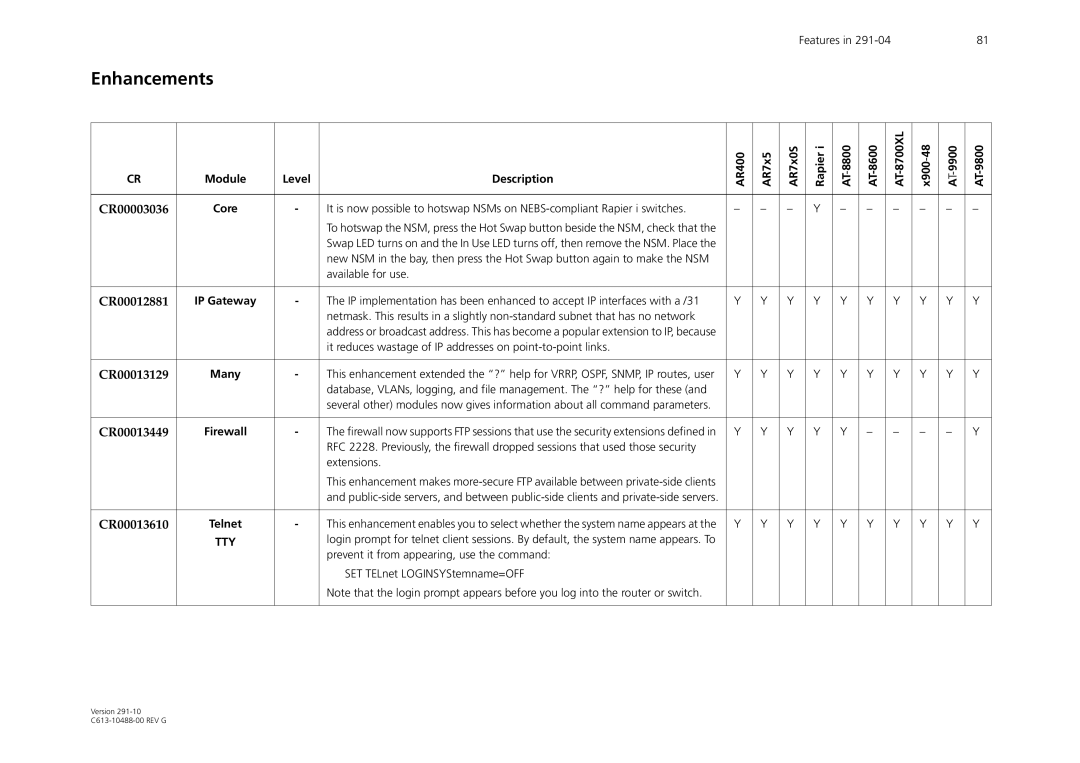Features in | 81 |
Enhancements
CR | Module | Level | Description | AR400 | AR7x5 | AR7x0S | Rapier i | AT8800- | x90048- | ||||
|
|
|
|
|
|
|
|
|
|
|
|
|
|
CR00003036 | Core | - | It is now possible to hotswap NSMs on | – | – | – | Y | – | – | – | – | – | – |
|
|
| To hotswap the NSM, press the Hot Swap button beside the NSM, check that the |
|
|
|
|
|
|
|
|
|
|
|
|
| Swap LED turns on and the In Use LED turns off, then remove the NSM. Place the |
|
|
|
|
|
|
|
|
|
|
|
|
| new NSM in the bay, then press the Hot Swap button again to make the NSM |
|
|
|
|
|
|
|
|
|
|
|
|
| available for use. |
|
|
|
|
|
|
|
|
|
|
|
|
|
|
|
|
|
|
|
|
|
|
|
|
CR00012881 | IP Gateway | - | The IP implementation has been enhanced to accept IP interfaces with a /31 | Y | Y | Y | Y | Y | Y | Y | Y | Y | Y |
|
|
| netmask. This results in a slightly |
|
|
|
|
|
|
|
|
|
|
|
|
| address or broadcast address. This has become a popular extension to IP, because |
|
|
|
|
|
|
|
|
|
|
|
|
| it reduces wastage of IP addresses on |
|
|
|
|
|
|
|
|
|
|
|
|
|
|
|
|
|
|
|
|
|
|
|
|
CR00013129 | Many | - | This enhancement extended the “?” help for VRRP, OSPF, SNMP, IP routes, user | Y | Y | Y | Y | Y | Y | Y | Y | Y | Y |
|
|
| database, VLANs, logging, and file management. The “?” help for these (and |
|
|
|
|
|
|
|
|
|
|
|
|
| several other) modules now gives information about all command parameters. |
|
|
|
|
|
|
|
|
|
|
|
|
|
|
|
|
|
|
|
|
|
|
|
|
CR00013449 | Firewall | - | The firewall now supports FTP sessions that use the security extensions defined in | Y | Y | Y | Y | Y | – | – | – | – | Y |
|
|
| RFC 2228. Previously, the firewall dropped sessions that used those security |
|
|
|
|
|
|
|
|
|
|
|
|
| extensions. |
|
|
|
|
|
|
|
|
|
|
|
|
| This enhancement makes |
|
|
|
|
|
|
|
|
|
|
|
|
| and |
|
|
|
|
|
|
|
|
|
|
|
|
|
|
|
|
|
|
|
|
|
|
|
|
CR00013610 | Telnet | - | This enhancement enables you to select whether the system name appears at the | Y | Y | Y | Y | Y | Y | Y | Y | Y | Y |
| TTY |
| login prompt for telnet client sessions. By default, the system name appears. To |
|
|
|
|
|
|
|
|
|
|
|
|
| prevent it from appearing, use the command: |
|
|
|
|
|
|
|
|
|
|
|
|
| SET TELnet LOGINSYStemname=OFF |
|
|
|
|
|
|
|
|
|
|
|
|
| Note that the login prompt appears before you log into the router or switch. |
|
|
|
|
|
|
|
|
|
|
|
|
|
|
|
|
|
|
|
|
|
|
|
|
Version
